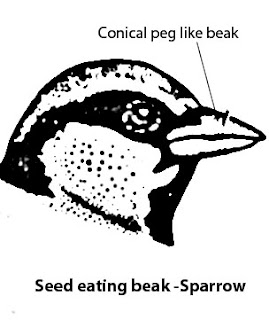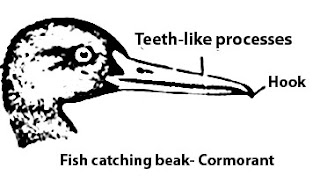Identification of Poisonous and non-poisonous snakes
Near about 2500 to 3000 species of snake found all over the world. But not all the species of snake are poisonous. Because of few of them, entire snake world have bad reputation.
According to WHO in India about 45000 to 50000 victims die due to snake bite every year. But official record is only about 12000 to 15000.
If the ventral scales are large transverse plates extending fully across the ventral side of belly, the snake may be poisonous or non-poisonous. Now examine the dorsal scales of the head
5. Identification of snake by nature head shield or scales.
If dorsal side of head is covered with shields. The snake may be poisonous or non-poisonous.
If head is covered with smaller scale, then snake is viper and it is poisonous snake.
If head is covered with smaller scales and there is lorea pit. it is pit viper and snake is poisonous.
6. Identification of snake by nature of vertebral.
if mid-dorsal side shows presence of hexagonal scales called as vertebral the snake is poisonous and it is krait. In addition to vertebral krait can be identified by examining 4th infra-labial shield and single row of sub-caudal.
Near about 2500 to 3000 species of snake found all over the world. But not all the species of snake are poisonous. Because of few of them, entire snake world have bad reputation.
According to WHO in India about 45000 to 50000 victims die due to snake bite every year. But official record is only about 12000 to 15000.
About 350 species of snake are poisonous. In India 216 species of snake are found and about 52 specis are poisonous .
Many
snakes are similar in appearance and colour patterns. So, there is need
of clear cut identification of poisonous and non-poisonous snake.
Majority of snakes are non-poisonous and harmless. The non-poisnous
snakes are python, rat snake, trinket snake, freshwater snake, etc. the
common poisonous snakes found in India are cobra, king cobra, Indian
viper, russel’s viper, krait, coral snake, sea snake,
Identification of poisonous and non-poisonous snake is not hard task.
Identification of poisonous and non-poisonous snake is not hard task.
Following key will serve to distinguish poisonous and non-poisonous snake.
1. Identification of snake by the nature of bite mark
2. Identification of snake by flow of blood from wound
3. Identification of snake by nature of tail.
4. Identification of snake by nature head shield or scales.
1. Identification of snake by the nature of bite mark
2. Identification of snake by flow of blood from wound
3. Identification of snake by nature of tail.
4. Identification of snake by nature head shield or scales.
5. Identification of snake by vertabrial
6. Identification of snake by ventral scales.
1. Identification of snake by the nature of bite mark:
If non-poisnous snake bites tends to several small punctures in two rows due to maxillary teeth mark and palatine teeth mark.
But if poisonous snake bite it shows two prominent spots due to fang , along with palatine teeth mark.
2. Identification of snake by flow of blood from wound
When non-poisonous snake bites, blood flows from wound for short period and get clot naturally but if poisnous snake bites, blood coloured fluid continuously oozes through the wound because venom prevent clotting of blood.
3. Identification of snake by nature of tail.
If tail is flattened and laterally compressed then snake is sea snake and deadly poisonous.
If we observed the tail is rounded and cylindrical, it is land snake. Then, snake may be poisonous or non-poisonous.
1. Identification of snake by the nature of bite mark:
If non-poisnous snake bites tends to several small punctures in two rows due to maxillary teeth mark and palatine teeth mark.
But if poisonous snake bite it shows two prominent spots due to fang , along with palatine teeth mark.

2. Identification of snake by flow of blood from wound
When non-poisonous snake bites, blood flows from wound for short period and get clot naturally but if poisnous snake bites, blood coloured fluid continuously oozes through the wound because venom prevent clotting of blood.
3. Identification of snake by nature of tail.
If tail is flattened and laterally compressed then snake is sea snake and deadly poisonous.
If we observed the tail is rounded and cylindrical, it is land snake. Then, snake may be poisonous or non-poisonous.
4. Identification of snake by nature the nature of ventral scales.
If ventral scales are broader and extending fully acros the belly. Snake may be poisonous or non-poisonous .
If the ventral scales are large transverse plates extending fully across the ventral side of belly, the snake may be poisonous or non-poisonous. Now examine the dorsal scales of the head
5. Identification of snake by nature head shield or scales.
If dorsal side of head is covered with shields. The snake may be poisonous or non-poisonous.
Head shield:
If 3rd supra-labial shield touches to the nostril and eye then snake is poisonous. The snake may be cobra king cobra and coral snake.
But if 3rd supra labial shield not touched to the nostril and eye then snake is non-poisonous and snake may be rat snake.
If
the snakes has a small scales and large shield on the head but does not
have the characters of cobra, or rat snake then examine ventral side
of head. If 4th infralabial shield extending fully from ventral side of head. Then it is poisonous snake and snake may be krait.
Scales on head If head is covered with smaller scale, then snake is viper and it is poisonous snake.
If head is covered with smaller scales and there is lorea pit. it is pit viper and snake is poisonous.
6. Identification of snake by nature of vertebral.
if mid-dorsal side shows presence of hexagonal scales called as vertebral the snake is poisonous and it is krait. In addition to vertebral krait can be identified by examining 4th infra-labial shield and single row of sub-caudal.































